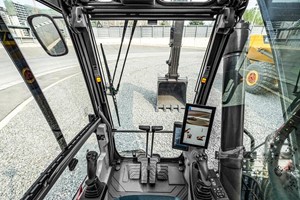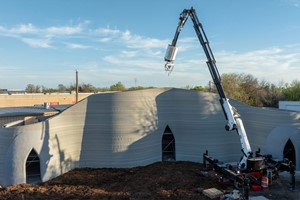Digital twins are becoming one of the most important technology trends for transportation infrastructure because of their potential to improve design, visually enhance collaboration, and increase asset reliability and performance. Digital twins can be considered the backbone of infrastructure decision-making as they provide up-to-date information about projects, their status, and the risks associated with them. Digital twins provide civil engineers with the ability to visualize assets across their entire lifecycle to track change and to perform analysis that optimizes asset performance.
What Are Digital Twins?
A digital twin is a digital representation of a physical asset, process, or system, as well as the engineering information that allows us to understand and model its performance. Plainly stated, a digital twin is a highly detailed digital model that is the counterpart (or twin) of a physical asset. Digital twins are continuously updated with data from multiple sources – which is what makes them different from static, 3D models.
Why Are Digital Twins Important?
From concept to operations, contractors, construction firms, and road and bridge owner-operators can leverage digital twins to allow project teams to gain more visibility into the design. Digital twins also allow management and owners to understand the implications of design decisions early in the process and help them achieve improved performance across the asset lifecycle. During the planning, design, and construction of a new road or bridge or major upgrade, project digital twins can optimize the design in line with operational requirements and reduce the risk of delayed or nonconformant construction through simulation. Project digital twins can also improve logistics and communication within the supply chain, which can help maintain the schedule and budget. It is during operations that performance digital twins become the most valuable. Owner-operators gain insight when inputs from Internet of Things (IoT) connected devices, such as drones that deliver continuous surveys to provide real-time tracking of asset changes in real-world conditions, add to the digital representation. This transparency helps owner-operators prioritize and improve maintenance or upgrades. When artificial intelligence (AI) and machine learning (ML) is applied, analytics visibility gained from big data can provide insight and immersive digital operations to enhance the effectiveness of operations and maintenance. The upshot is that access to performance digital twins might enable staff to anticipate and avoid issues before they arise or improve their reaction times. With the application of drones and robots, along with AI-based computer vision, automating inspection tasks using a digital twin, experts can conduct inspections remotely, increase productivity, leverage the value of specialists, and reduce the risks that come with exposing team members to dangerous environments.
Why Road Agencies Need Digital Twins
- Empower your supply chain to help you meet project and operational goals
- Unify and integrate multiple siloed data sources
- Systematically track, manage, and visualize change
- Produce actionable insights for key decision makers
- Enable high-performing, collaborative teams
Road and Bridge Digital Twins in Action
Bentley sees its users going digital with digital twins, advancing digital workflows and using intelligent components, and digital context to improve project delivery and/or enable assets to perform better, every day and all around the world.
Here are a few examples that illustrate how Bentley users are going digital in their project work.
Italferr Uses Digital Twins to Build Pergenova Viaduct in Genoa, Italy
The Pergenova Consortium Company chose Italferr to design an emergency replacement for the 1,182-meter Morandi Bridge over the Polcevera River in Genoa Italy. The collapsed bridge closed three rail lines and added 120 kilometers to road travel. Consequently, rebuilding it as quickly as possible was critical for the city’s long-term economic and cultural health—and construction would need to begin as
the design progressed. To ensure the accuracy of the design while staying on schedule, Italferr used Bentley’s BIM methodology and created a digital twin of the viaduct to streamline workflows throughout the design phase. To achieve this goal, Italferr incorporated detailed information for construction and operation into the model, as there was little time to significantly alter the model after the design phase. The organization also established an open, connected data environment to promote collaboration among the multidiscipline project team and ensure a single source of truth. Bentley applications also helped Italferr define standards, templates, and basic criteria to create a digital twin and a unified 3D information model that forms the basis for design, construction, and operation. Leveraging BIM and creating a digital workflow with Bentley applications allowed Italferr to visualize the design with a much higher degree of quality and speed than traditional 2D designs. Using Bentley’s BIM solutions and digital twins, Italferr reduced design costs, improved decision-making, increased accuracy, and improved multidiscipline communication.
BIM Advancements and Digital Twins Optimize Design and Construction of Chinese Expressway
Meitan-Shiqian Expressway is a key project in the 13th Five-Year Plan for Transportation Development in China’s Guizhou province. It is the first expressway in China that applies BIM methodologies for construction and management in large quantities and in all disciplines. Located in a very mountainous area, the expressway is 113 kilometres long with numerous bridges, elevated highways, and tunnels. The project leveraged digital twins to improve the quality of expressway construction and implement the concept of full lifecycle management. Unmanned aerial vehicles were flown to survey the existing site and Bentley’s reality modeling software was used to create a 3D reality model. Having this reality context helped the team accelerate and optimize the design, shortening the construction period by 89 days. The introduction of virtual design and construction technologies has transformed the traditional construction lifecycle on this project. The project team identified issues in the design stage that would not have been found and solved until the construction stage using previous methods. Identifying problems at the design stage cut the design effort and time in half, improved construction quality, and reduced construction costs. The BIM models collected during the project were used to establish a digital twin, which provides the foundation for maintenance and for modeling and predicting future asset performance.
Summary
Digital twins enable you to visualize infrastructure assets across the entire asset lifecycle, track change, and perform analysis to optimize asset performance. Bentley’s infrastructure digital twins combine engineering data, reality data, and IoT data for a holistic view of infrastructure aboveground and belowground. Immersive visualization, visibility, and analytics help you achieve a deeper understanding of your infrastructure assets—so that you can improve your decision-making for better outcomes.













